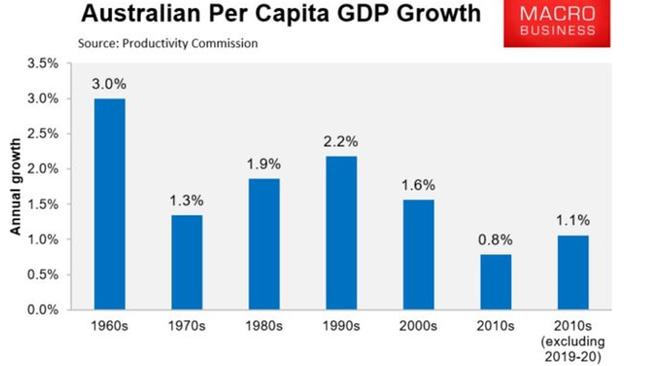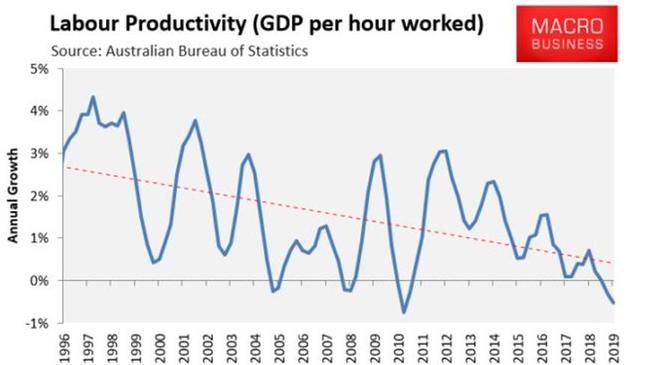Morrison or Albanese: Who is really better for the economy?
The economy has been front and centre of the election campaign, but now analysis shows which leader will make you better off as PM.
Economy
Don't miss out on the headlines from Economy. Followed categories will be added to My News.
ANALYSIS
Fundamentally, the two major political parties share an outlook on the Australian economy. Both prefer a mass immigration-driven economy to the traditional model of advancing productivity. This economic model delivers headline GDP growth, which politicians love to claim is their doing.
However, under the bonnet of this economic growth model there are very different winners and losers to the traditional path of economic reform.
Immigration-led growth benefits existing capital holders over workers by putting upwards pressure on asset prices and downwards pressure on wages.

It also favours those sectors that enjoy a larger population like banking, retail, education and real estate over such sectors as manufacturing, exporters or technology where competition is the key driver of growth.
It is an easy form of growth that delivers GDP but not GDP per capita which is the only way to lift broadbased living standards.
In terms of the more immediate growth outlook, dark clouds gathering over the global economy as interest rate rise may lead to economic storms in Australia as well. In that event, both political parties are sensible enough to spend if needed to support any retrenchment in the private sector.

Productivity
Of all the long-term drivers of the Australian economy, boosting productivity is by far the most important for raising living standards, since it allows more goods/services to be produced (consumed) from the same amount of effort.
Australia’s recent productivity performance has been dreadful, yet neither side has addressed the issue over the election campaign, nor promised to tackle difficult structural or tax reforms to lift productivity.
Labor perhaps holds a slight edge in this area owing to its promise to boost apprenticeships and traineeships, alongside funding 465,000 fee free TAFE places, and 20,000 additional university places.
While not strictly a productivity measure, Labor will also reduce the cost of childcare for 96 per cent of families, which should at the margin increase labour force participation rates.
The Productivity Commission is due to release its review of Australian productivity next February. So ultimately, Australia’s future productivity performance will depend on how the next federal government responds to its recommendations, regardless of which side wins.

Budget
Both parties will run budget deficits for as far as the eye can see. In the pre-election Budget, the Morrison government forecast $114bn in deficits over the four-year forward estimates. This will probably have improved slightly by now thanks to booming commodity prices. It has also added some $16bn in pork over the election campaign which will be of questionable economic value.
Labor has not released its policy costings yet but is likely to run a larger deficit in the range of $10bn over the four years, according to reports.
However, its spending is better targeted for economic benefit and includes larger commitments to productivity-enhancing infrastructure, child care support and training.
The Coalition, therefore, has the edge on the Budget if less spending is the benchmark but if the quality of spending is the metric, then Labor has the edge.
Wages
Labor holds a clear advantage over the Coalition on wages.
Labor supports the minimum wage increasing by the rate of inflation, whereas Prime Minister Scott Morrison has sided with the business lobby and endorsed a below-inflation rise.
While the ultimate decision around the minimum wage will be made by the Fair Work Commission, Labor’s stance suggests around two million workers would be better off under Labor than the Coalition.
Labor has promised to make job security an object of the Fair Work Act; promised to extend the powers of the Fair Work Commission to improve minimum standards for new forms of work, such as gig work; promised to improve pathways to permanent work for casual workers; as well as committed to making wage theft a criminal offence.
Labor has also expressed opposition to excessive temporary migration and has promised to review migration settings post-election. Temporary migrants are over represented in cases of wage theft and exploitation and therefore tend to put downward pressure on overall wage growth.
By contrast, the Coalition has promised little around wages and has regularly sided with business groups pushing for lower wage demands.
Interest rates
While interest rates are set independently by the Reserve Bank, the federal government influences interest rates via the impact of fiscal policy on inflation.
Not much separates the two parties on this issue; although Labor probably has a slight edge.
Labor’s push for higher wages will put upward pressure on inflation and ergo interest rates (other things equal). Labor has also committed to running slightly bigger deficits than the Coalition, due in part to its $5.4 billion childcare package, which could provide more stimulus to the economy.
However, the Coalition’s promise to allow first home buyers to spend up to $50,000 of their superannuation savings on housing is inflationary via: 1) instantly inflating house prices and unleashing another wealth effect to drive consumption; and 2) placing further upward pressure on housing construction costs that are already running hot.
Housing is the largest component of the Australian CPI, and the Coalition’s latest super-housing policy would add further fuel to the inflationary bonfire.
Energy transformation
Energy is a crucial input into the economy in terms of cost, reliability, and climate change.
On cost, Labor has the advantage because it is less wedded to fossil fuel providers. Coal and especially gas costs have spiked since the Russia-Ukraine war began and that is already delivering higher gas and power prices to Australia.
Australia could and perhaps should keep more of its own cheap gas for itself but neither party is proposing to do so, though both have done so in the past.
Renewables are now materially cheaper than fossil fuel power so policies to promote a swifter rollout of low-carbon energy will also deliver lower utility bills.
Reliability questions are largely a furphy with the rise of cheaper and cheaper energy storage options.
Again, Labor has the advantage in its push for more renewables with the obvious consequence of less carbon pollution to go with it.
Conclusion
In the 2022 election, neither party is interested in addressing the fundamental changes needed to lift Australian living standards.
The Coalition is focused on making hay for its base of capital holders and swing seats.
Labor is playing around the edges to soften the downsides of the current economic model for workers without doing the harder reforms that would make them all better off.
The largest difference is in energy policy where Labor holds a clear lead.
David Llewellyn-Smith is Chief Strategist at the MB Fund and MB Super. David is the founding publisher and editor of MacroBusiness and was the founding publisher and global economy editor of The Diplomat, the Asia Pacific’s leading geopolitics and economics portal.
Leith van Onselen is Chief Economist at the MB Fund and MB Super. Leith has previously worked at the Australian Treasury, Victorian Treasury and Goldman Sachs.
Originally published as Morrison or Albanese: Who is really better for the economy?




